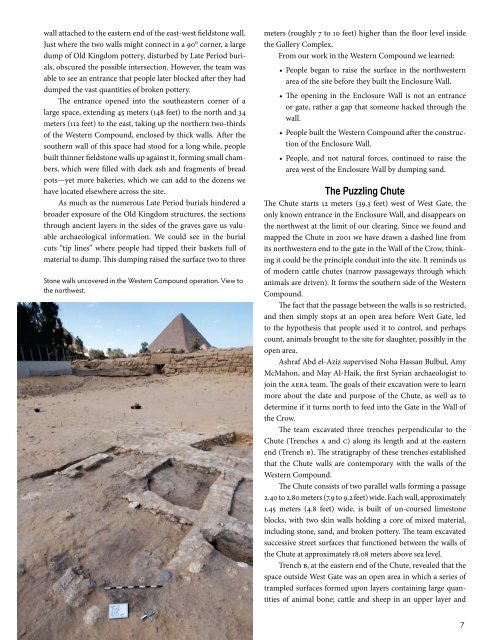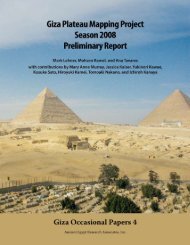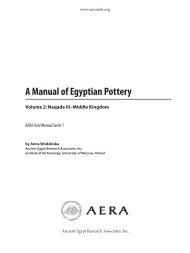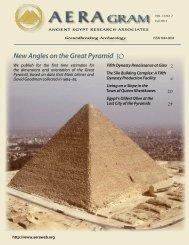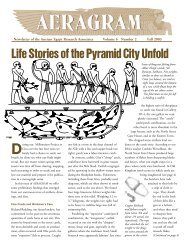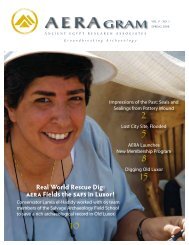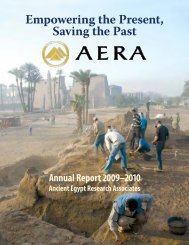Download a PDF of our 2009 Annual Report - Ancient Egypt ...
Download a PDF of our 2009 Annual Report - Ancient Egypt ...
Download a PDF of our 2009 Annual Report - Ancient Egypt ...
You also want an ePaper? Increase the reach of your titles
YUMPU automatically turns print PDFs into web optimized ePapers that Google loves.
wall attached to the eastern end <strong>of</strong> the east-west fieldstone wall.<br />
Just where the two walls might connect in a 90° corner, a large<br />
dump <strong>of</strong> Old Kingdom pottery, disturbed by Late Period burials,<br />
obscured the possible intersection. However, the team was<br />
able to see an entrance that people later blocked after they had<br />
dumped the vast quantities <strong>of</strong> broken pottery.<br />
The entrance opened into the southeastern corner <strong>of</strong> a<br />
large space, extending 45 meters (148 feet) to the north and 34<br />
meters (112 feet) to the east, taking up the northern two-thirds<br />
<strong>of</strong> the Western Compound, enclosed by thick walls. After the<br />
southern wall <strong>of</strong> this space had stood for a long while, people<br />
built thinner fieldstone walls up against it, forming small chambers,<br />
which were filled with dark ash and fragments <strong>of</strong> bread<br />
pots—yet more bakeries, which we can add to the dozens we<br />
have located elsewhere across the site.<br />
As much as the numerous Late Period burials hindered a<br />
broader exposure <strong>of</strong> the Old Kingdom structures, the sections<br />
through ancient layers in the sides <strong>of</strong> the graves gave us valuable<br />
archaeological information. We could see in the burial<br />
cuts “tip lines” where people had tipped their baskets full <strong>of</strong><br />
material to dump. This dumping raised the surface two to three<br />
Stone walls uncovered in the Western Compound operation. View to<br />
the northwest.<br />
meters (roughly 7 to 10 feet) higher than the floor level inside<br />
the Gallery Complex.<br />
From <strong>our</strong> work in the Western Compound we learned:<br />
• People began to raise the surface in the northwestern<br />
area <strong>of</strong> the site before they built the Enclosure Wall.<br />
• The opening in the Enclosure Wall is not an entrance<br />
or gate, rather a gap that someone hacked through the<br />
wall.<br />
• People built the Western Compound after the construction<br />
<strong>of</strong> the Enclosure Wall.<br />
• People, and not natural forces, continued to raise the<br />
area west <strong>of</strong> the Enclosure Wall by dumping sand.<br />
The Puzzling Chute<br />
The Chute starts 12 meters (39.3 feet) west <strong>of</strong> West Gate, the<br />
only known entrance in the Enclosure Wall, and disappears on<br />
the northwest at the limit <strong>of</strong> <strong>our</strong> clearing. Since we found and<br />
mapped the Chute in 2001 we have drawn a dashed line from<br />
its northwestern end to the gate in the Wall <strong>of</strong> the Crow, thinking<br />
it could be the principle conduit into the site. It reminds us<br />
<strong>of</strong> modern cattle chutes (narrow passageways through which<br />
animals are driven). It forms the southern side <strong>of</strong> the Western<br />
Compound.<br />
The fact that the passage between the walls is so restricted,<br />
and then simply stops at an open area before West Gate, led<br />
to the hypothesis that people used it to control, and perhaps<br />
count, animals brought to the site for slaughter, possibly in the<br />
open area.<br />
Ashraf Abd el-Aziz supervised Noha Hassan Bulbul, Amy<br />
McMahon, and May Al-Haik, the first Syrian archaeologist to<br />
join the AERA team. The goals <strong>of</strong> their excavation were to learn<br />
more about the date and purpose <strong>of</strong> the Chute, as well as to<br />
determine if it turns north to feed into the Gate in the Wall <strong>of</strong><br />
the Crow.<br />
The team excavated three trenches perpendicular to the<br />
Chute (Trenches A and C) along its length and at the eastern<br />
end (Trench B). The stratigraphy <strong>of</strong> these trenches established<br />
that the Chute walls are contemporary with the walls <strong>of</strong> the<br />
Western Compound.<br />
The Chute consists <strong>of</strong> two parallel walls forming a passage<br />
2.40 to 2.80 meters (7.9 to 9.2 feet) wide. Each wall, approximately<br />
1.45 meters (4.8 feet) wide, is built <strong>of</strong> un-c<strong>our</strong>sed limestone<br />
blocks, with two skin walls holding a core <strong>of</strong> mixed material,<br />
including stone, sand, and broken pottery. The team excavated<br />
successive street surfaces that functioned between the walls <strong>of</strong><br />
the Chute at approximately 18.08 meters above sea level.<br />
Trench B, at the eastern end <strong>of</strong> the Chute, revealed that the<br />
space outside West Gate was an open area in which a series <strong>of</strong><br />
trampled surfaces formed upon layers containing large quantities<br />
<strong>of</strong> animal bone; cattle and sheep in an upper layer and<br />
7


